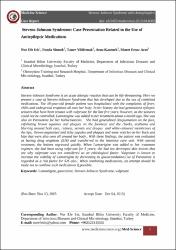Stevens-Johnson Syndrome: Case presentation related to the use of antiepileptic medications
Künye
Iris NE, Simsek F, Yildirmak T, Kanturk A, Arat ME. Stevens-Johnson Syndrome: Case Presentation Related to the Use of Antiepileptic Medications. Med-Science. 2015. doi:10.5455/medscience.2015.04.8383Özet
Stevens-Johnson Syndrome is an acute allergic reaction that can be life-threatening. Here we present a case of Stevens-Johnson Syndrome that has developed due to the use of combined medications. The 18-year-old female patient was hospitalized with the complaints of fever, chills and widespread eruptions all over her body. In her history she had generalized epileptic seizures that have been treated with valproate for the last five years; however, as the seizures could not be controlled , Lamotrigine was added to her treatment about a month ago. She was also on Paroxetine for her hallucinations. She had generalized desquamation on the face, exfoliating brown squames and plaques on the forehead and the cheeks, erythema and blurring around both eyes, redness, xerosis and desqua and white-coloured membranes of the lips, brown-pigmented and itchy papules and plaques and some vesicles on her back and hips that were also seen all around her body.. With these findings, the patient was evaluated as having drug eruptions (SJS) and transferred to the intensive care unit. With steroid treatment , the lesions regressed quickly. When Lamotrigine was added to her treatment regimen, she had been using valproate for 5 years; she had not developed skin lesions, that is why valproate was not considered as an ethiological factor. Valproate is known to increase the viability of Lamotrigine by decreasing its glucuronidation.Use of Paroxetine is regarded as a risk factor for SJS also.. When combining medications, an attempt should be made not to combine such medications if possible.


















